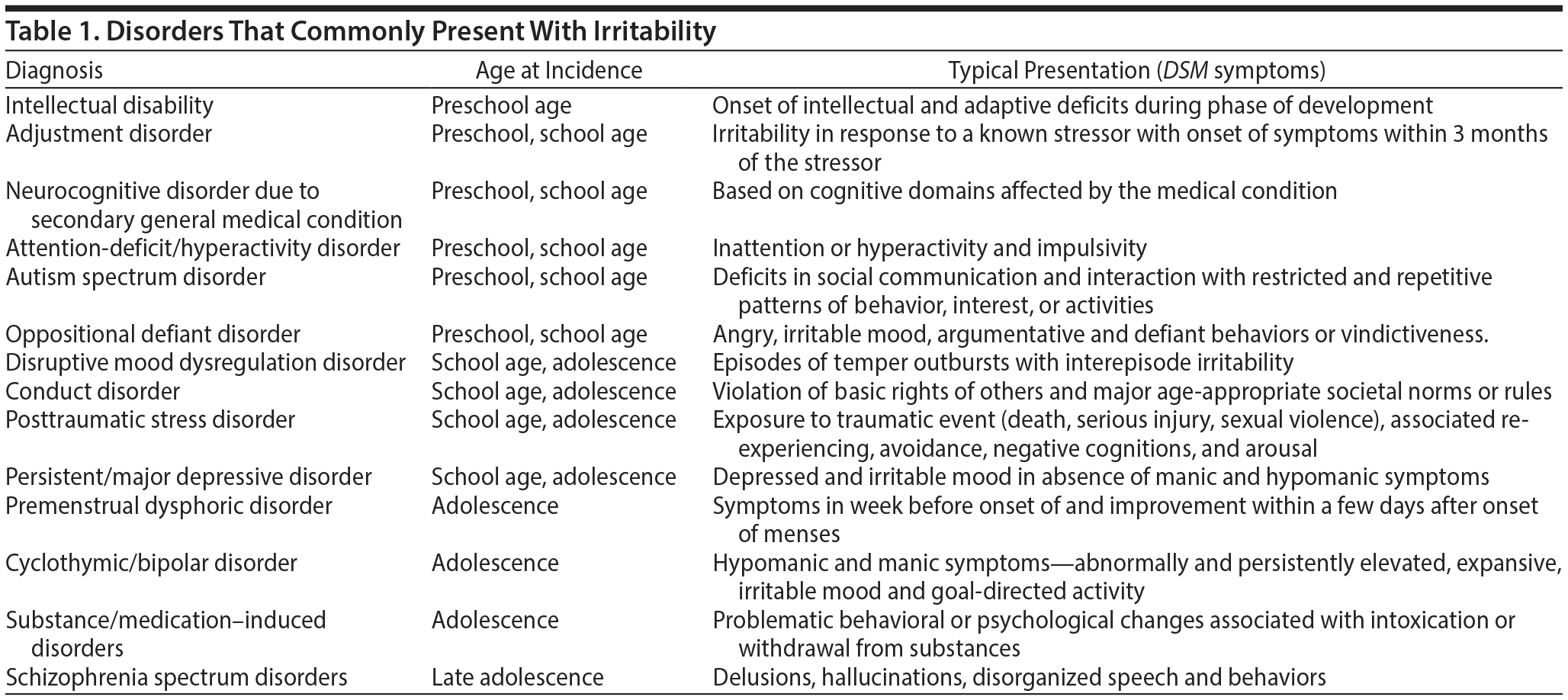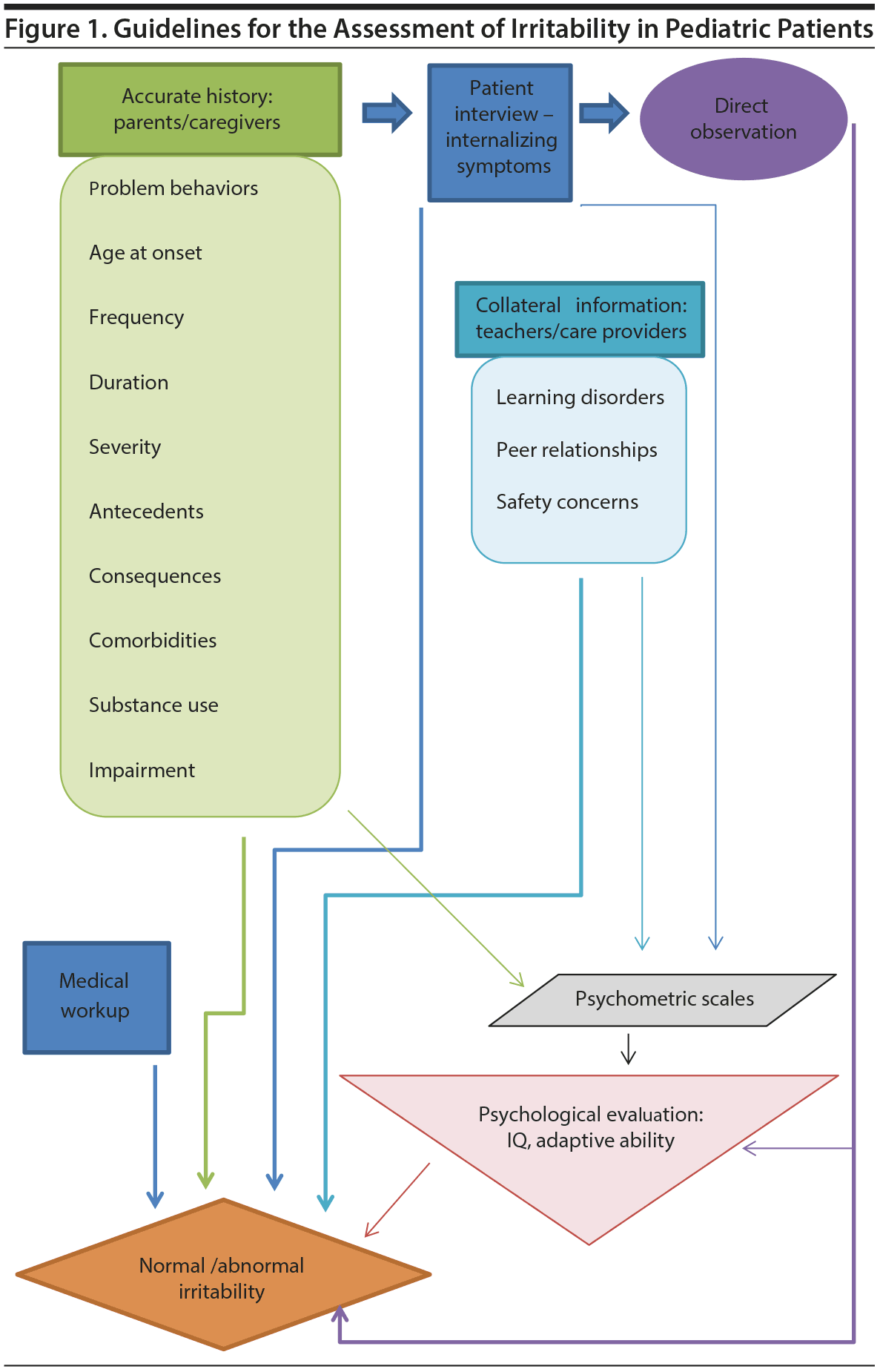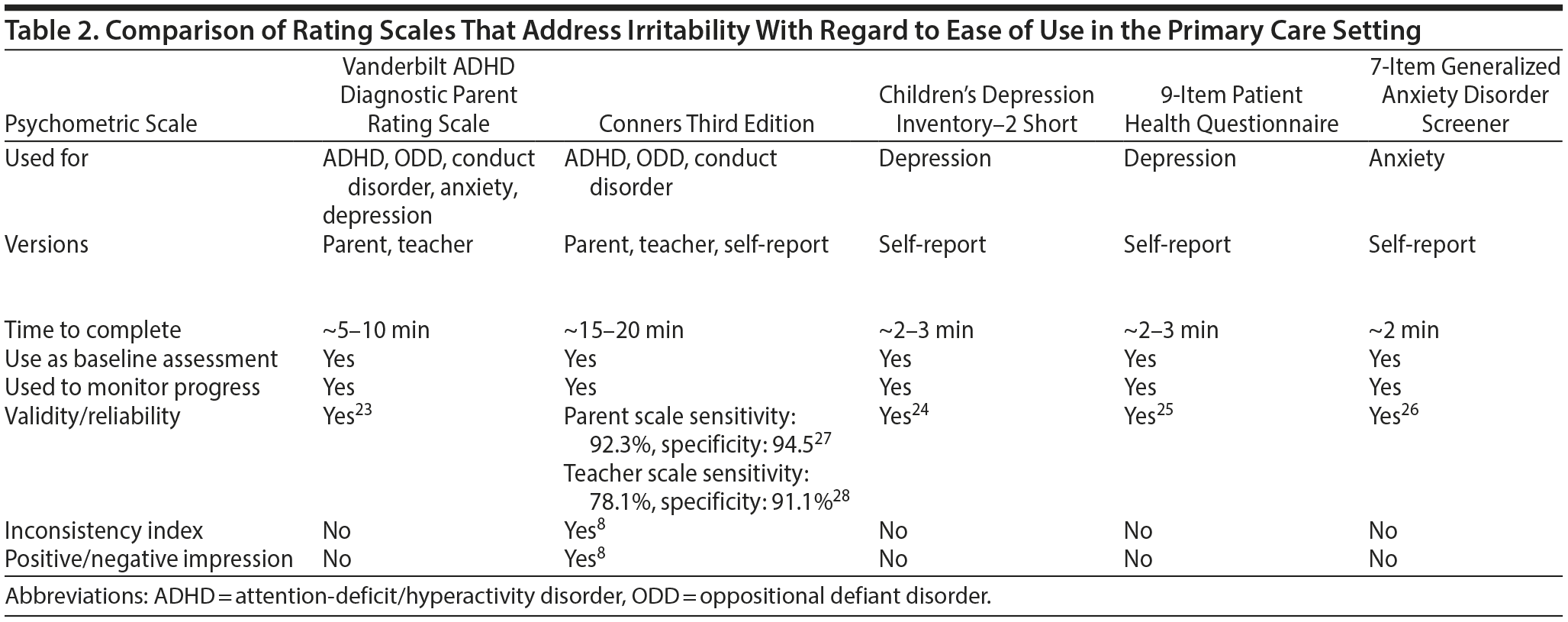The goal of this article is to describe the concept of irritability in children and youth, which has been revisited in the DSM-5. Traditionally, this behavior has been more commonly associated with mood disorders, which may account for the rising incidence of bipolar disorder diagnosis and overuse of mood-stabilizing medications in pediatric patients. While not predictive of mania, persistent nonepisodic irritability, if undetected, may escalate to violent behavior with potentially serious outcomes. It is therefore important to educate clinicians about how to accurately assess irritability in pediatric patients.’ ‹
Irritability in Pediatric Patients:
Normal or Not?
ABSTRACT
The goal of this article is to describe the concept of irritability in children and youth, which has been revisited in the DSM-5. Traditionally, this behavior has been more commonly associated with mood disorders, which may account for the rising incidence of bipolar disorder diagnosis and overuse of mood-stabilizing medications in pediatric patients. While not predictive of mania, persistent nonepisodic irritability, if undetected, may escalate to violent behavior with potentially serious outcomes. It is therefore important to educate clinicians about how to accurately assess irritability in pediatric patients.
Prim Care Companion CNS Disord 2016;18(2):doi:10.4088/PCC.15br01893
© Copyright 2016 Physicians Postgraduate Press, Inc.
aDepartment of Psychiatry, Pennsylvania State University, Hershey
bDepartment of Humanities, Pennsylvania State University, Hershey
*Corresponding author: Usman Hameed, MD, FAPA, Pennsylvania State University, College of Medicine,
22 Northeast Dr, Hershey, PA 17033
([email protected]).
The concept of irritability in children and youth has been revisited in the DSM-5. Traditionally, this behavior has been more commonly associated with mood disorders, which may account for the rising incidence of bipolar disorder diagnosis and overuse of mood-stabilizing medications in pediatric patients. While not predictive of mania, persistent nonepisodic irritability, if undetected, may escalate to violent behavior with potentially serious outcomes. It is therefore important to educate clinicians about how to accurately assess irritability in pediatric patients.
IRRITABILITY
Definition
Irritability exists on a continuum from normal developmental tantrums to extremely aggressive behaviors,1 which can vary with chronological and developmental age, physical and emotional status, environment, and support. However, clinicians are more likely to rely on a simple explanation of irritability as frustration in response to not getting what one wants or reactive aggression.2 One method used to define irritability is use of rating scales that look at level of hypersensitivity, duration, and intensity. Another approach is to consider adding items such as “gets angry or annoyed easily” and “loses temper and has tantrums” on psychometric scales addressing behavioral symptoms.3 A more in-depth method would involve description of antecedents, frequency, and severity of tantrums, as well as severity and persistence of interval mood. Irritability is not well defined as an independent construct in the clinical literature. However, some scholarly articles attempt to describe this concept and its implications.
For example, Judd and colleagues4 found that overt irritability or anger during an episode of major depression is a clinical marker of a more severe, chronic, and complex disease. Tseng et al5 examined preschoolers with high versus low familial risk for bipolar disorder and found high-risk preschoolers to demonstrate clinically significant issues with anger modulation and behavior dysregulation. In a clinically oriented report, Keel6 describes how irritability and fatigue associated with chronic stress can clinically present with fear of somatic illness or decreased productivity. Mayes et al3 describe the trajectory of irritability throughout childhood and adolescence. Their study population of 376 children indicated instability of irritable behaviors—angry mood symptoms over an 8-year period—suggesting that these symptoms are a feature of multiple disorders and do not occur in isolation. Also, the flux of irritable behaviors can create challenges for clinicians who seek to rule out or include specific diagnoses. Since disruptive mood dysregulation disorder is conceptualized as a chronic persistent disorder, the validity of the disorder as an independent diagnosis is in question.3
Components
A National Institute of Mental Health workshop on childhood irritability described 2 components: (1) tonic component described as a persistently angry, grumpy, or grouchy mood and (2) phasic component described as behavioral outbursts of intense anger.7
Clinical Implications
Irritability in children is a common behavior that prompts parents, teachers, and others to seek primary care or mental health input from professionals. It is essential to establish the presence or absence of abnormal irritability because it can place the individual at risk of functional impairment.7 Even more important is the process of screening for behaviors associated with irritability, such as physical aggression involving the use of a weapon, animal cruelty, fire setting, breaking and entering, and confrontational stealing, which might require immediate attention or referral to mental health services.8
DISRUPTIVE MOOD DYSREGULATION DISORDER
Disruptive mood dysregulation disorder is a new addition to the depressive disorder category in the DSM-5.9 This diagnosis evolved from 2 conditions identified previously: severe mood dysregulation10 and temper dysregulation disorder with dysphoria.11 Severe mood dysregulation is a syndrome defined to capture symptoms that do not meet criteria for bipolar disorder in children and, yet, lead to significant functional impairment.
Disruptive mood dysregulation disorder was intended to capture temper outbursts and define nonepisodic irritability in children beyond what may be considered normal. The importance of identifying normal versus abnormal irritability is that the incidence of bipolar disorder diagnosis and treatment with mood-stabilizing medication in the pediatric population is increasing dramatically.12,13 The increased incidence of pediatric bipolar disorder in the United States is controversial.14 This diagnosis has been used by default in pediatric patients who presented to primary care and specialty clinics with irritable or angry mood and functional impairment.15 Incorrect diagnosis and limited availability or lack of appropriate psychoeducational and behavioral management support services to these children may contribute to such an increase. Nonepisodic irritability does not predict bipolar disorder,10 but disruptive mood dysregulation disorder has a high co-occurrence with depressive and oppositional defiant disorders.16
Even though validity of disruptive mood dysregulation disorder as an independent diagnosis is controversial,3 this diagnosis may offer an alternative approach for providers who assess irritable mood in children.17–19 In addition, due to growing concerns about violent behaviors, which are often connected with irritability among youth, recognition of irritable mood and episodes of rage has become increasingly important at the primary care level.20
OVERVIEW OF THE DSM
The DSM is a classification of mental disorders with associated criteria so as to facilitate more reliable diagnoses of these disorders. The fifth edition of the DSM was released in May 2013.
The DSM-5 uses a more dimensional approach, as the rigid categorical system in the previous edition does not capture clinical experience or important scientific observations.21 Over the past 60 years, the successive editions of the manual have become a standard reference for clinical practice in the mental health field.
USE OF THE DSM IN CLINICAL SETTINGS
While the DSM serves as an authoritative resource for psychiatric providers, it is less often consulted by primary care providers who care for children such as family practitioners and pediatricians. A literature search for use of the DSM in primary care and pediatrics suggested use of certain screening tools based on DSM criteria, such as the Modified Checklist for Autism.22
However, the extent to which the DSM is used in primary care settings is unknown. These practitioners are most often the “gatekeepers” who will identify and diagnose psychiatric problems that warrant treatment in their patients, so an understanding of resources they can use to establish a diagnosis is critical.
We conducted 4 preliminary interviews with pediatric primary care providers and discovered that very few consult or understand the DSM to identify problems in the clinical setting. The review of scholarly literature on irritability indicates limited data on this subject. Anecdotally, colleagues have affirmed the importance of separating normal from abnormal irritability in children. Table 1 describes several psychiatric diagnoses that have a component of irritability.

APPLICATION
Accurate identification of abnormal irritability is a necessary first step in establishing a diagnosis and then implementing a treatment plan. A lack of awareness about normal irritability can lead clinicians to believe a pediatric patient has a mental health diagnosis when, in fact, less invasive behavioral methods can be used to address the situation. For example, irritability associated with substance withdrawal would be treated differently than irritability from premenstrual dysphoric disorder, and both would be treated differently from abnormal irritability.
Clinicians in the medical and nursing professions provide care for children in a variety of settings: inpatient facilities, outpatient clinics, schools, and within the home. To assist with differentiating normal from abnormal irritability, we suggest use of the following guidelines, which will help determine whether irritability is within normal limits (Figure 1).

An assessment should begin with introductions and a brief overview of the process. Children may prefer to be seen with his or her parent(s) and adolescents may prefer independent interview. The first part of the assessment should include an accurate history from parents, the patient, and caregivers focusing on features of irritability and externalizing symptoms or acting-out behaviors. The history should include the following:
- Age at onset
- Progression and pattern—frequency, duration, severity
- Associated problem behaviors and consequences
- Possible stressors—recent change in life events
- Concurrent mental or physical illness
- Prenatal or postnatal exposure to substances
- Functional abilities.
A more thorough interview of the patient will help differentiate internalizing symptoms such as depression or anxiety and others that may require attention. Through direct observation of parent-child interaction, clinicians can observe the following:
- Interpersonal skills
- Communication skills
- Coping mechanisms.
Depending on the information obtained in the initial history, collateral information from teachers and other care providers (services in the home, school, or community) and their longitudinal observation may be very helpful. This information could include the following:
- Learning disorders
- Peer relationships
- Violent behaviors.
The use of standardized psychometric scales also may be indicated if clinicians need further information. Those that may address irritability are described as follows:
- The Vanderbilt ADHD Diagnostic Parent Rating Scale23 may be used to screen for associated attention-deficit/hyperactivity disorder (ADHD), oppositional defiant disorder, and conduct disorder. It also provides a broad screen for anxiety and low mood.
- The Conners Third Edition8 also may be used to screen for associated ADHD, oppositional defiant disorder, and conduct disorder. Advantages include the inconsistency index and positive/negative impression scale, which addresses possible inconsistent positive or negative response style.
- The Children’s Depression Inventory–2 Short24 may be used to screen for depression.
- The 9-item Patient Health Questionnaire25 modified for children and teens may be used to screen for depression.
- The 7-item Generalized Anxiety Disorder Screener26 may be used to screen for anxiety.
Table 2 compares these rating scales in terms of ease of use in the primary care setting.

Referral for a more in-depth psychological evaluation to consider IQ or achievement deficits may be indicated. Irritability due to inability to complete school work presented to the child can be screened using the following tests:
- Wechsler Intelligence Scale for Children—Fourth Edition29
- Wechsler Individual Achievement Test30
- Vineland Adaptive Behavior Scales.31
The physical component of the examination would include the following:
- Neurologic assessment for history of seizures or head injury
- Toxicology screen, thyroid function tests, complete blood count
- Endocrine assessment if indicated
- Vision and hearing
- Growth and development.
CONCLUSION
The accurate assessment of irritability is an important first step in the medical decision-making process for this commonly presenting symptom in the primary care setting. Although beyond the scope of this review article, appropriate management options such as reassurance, periodic monitoring, psychoeducation or therapy for the patient and family, intervention with medications or referral to metal health services, or specialized school services may be helpful strategies on the basis of such an assessment.
Although there are few diagnostic aides for specialized or primary care providers, it is extremely important to accurately identify the underlying cause of irritability. Among the pediatric population, there are numerous causes of irritability, ranging from normal developmental irritability to bipolar and psychotic disorders. Irritability in this age group should be carefully approached, as misdiagnosis can trigger a lifelong trajectory that involves inappropriate or unnecessary medications, therapy, and institutionalizations. On the other hand, pediatric patients with significant unresolved irritability can progress to acting-out behaviors with significant social, interpersonal, and academic difficulties or violent ways that bring harm to self and others.32 In either situation, a better understanding of normal versus abnormal irritability and clinical strategies for diagnosis are needed to assure the health and well-being of children, their families, and the community. We have attempted to describe the concept of irritability as documented in the literature, how neurobehavioral issues include irritability, and how organic and nonorganic disorders may present with this symptom. Since primary care providers are at the forefront in the treatment of pediatric patients, an understanding of how to accurately assess irritability is essential.
Submitted: October 12, 2015; accepted January 19, 2016.
Published online: March 24, 2016.
Potential conflicts of interest: None reported.
Funding/support: None reported.
REFERENCES
1. Snaith RP, Taylor CM. Irritability: definition, assessment, and associated factors. Br J Psychiatry. 1985;147(2):127–136. doi:10.1192/bjp.147.2.127 PubMed
2. Leibenluft E, Blair RJ, Charney DS, et al. Irritability in pediatric mania
and other childhood psychopathology. Ann N Y Acad Sci. 2003;1008(1):
201–218. doi:10.1196/annals.1301.022 PubMed
3. Mayes SD, Mathiowetz C, Kokotovich C, et al. Stability of disruptive mood dysregulation disorder symptoms (irritable-angry mood and temper outbursts) throughout childhood and adolescence in a general population sample. J Abnorm Child Psychol. 2015;43(8):1543–1549. doi:10.1007/s10802-015-0033-8 PubMed
4. Judd LL, Schettler PJ, Coryell W, et al. Overt irritability/anger in unipolar major depressive episodes: past and current characteristics and implications for long-term course. JAMA Psychiatry. 2013;70(11):1171–1180. doi:10.1001/jamapsychiatry.2013.1957 PubMed
5. Tseng WL, Guyer AE, Briggs-Gowan MJ, et al. Behavior and emotion modulation deficits in preschoolers at risk for bipolar disorder. Depress Anxiety. 2015;32(5):325–334. doi:10.1002/da.22342 PubMed
6. Keel P. Unexplained fatigue and irritability: differential diagnosis and practical procedures for signs of exhaustion [in German]. Praxis (Bern 1994). 2014;103(19):1117-1122.
7. Copeland WE, Brotman MA, Costello EJ. Normative irritability in youth: developmental findings from the Great Smoky Mountains Study. J Am Acad Child Adolesc Psychiatry. 2015;54(8):635–642. doi:10.1016/j.jaac.2015.05.008 PubMed
8. Conners CK. The Conners 3rd Edition (Conners 3). North Tonawanda, NJ: Multi-Health System; 2008.
9. Rao U. DSM-5: disruptive mood dysregulation disorder. Asian J Psychiatr. 2014;11:119–123. doi:10.1016/j.ajp.2014.03.002 PubMed
10. Leibenluft E. Severe mood dysregulation, irritability, and the diagnostic boundaries of bipolar disorder in youths. Am J Psychiatry. 2011;168(2):129–142. doi:10.1176/appi.ajp.2010.10050766 PubMed
11. Stringaris A. Irritability in children and adolescents: a challenge for DSM-5. Eur Child Adolesc Psychiatry. 2011;20(2):61–66. doi:10.1007/s00787-010-0150-4 PubMed
12. Roy AK, Lopes V, Klein RG. Disruptive mood dysregulation disorder: a new diagnostic approach to chronic irritability in youth. Am J Psychiatry. 2014;171(9):918–924. doi:10.1176/appi.ajp.2014.13101301 PubMed
13. Olfson M, Blanco C, Liu S-M, et al. National trends in the office-based treatment of children, adolescents, and adults with antipsychotics. Arch Gen Psychiatry. 2012;69(12):1247–1256. doi:10.1001/archgenpsychiatry.2012.647 PubMed
14. Post RM, Luckenbaugh DA, Leverich GS, et al. Incidence of childhood-onset bipolar illness in the USA and Europe. Br J Psychiatry. 2008;192(2):150–151. doi:10.1192/bjp.bp.107.037820 PubMed
15. Johnson K, McGuinness TM. Disruptive mood dysregulation disorder: a new diagnosis in the DSM-5. J Psychosoc Nurs Ment Health Serv. 2014;52(2):17–20. PubMed
16. Copeland WE, Angold A, Costello EJ, et al. Prevalence, comorbidity, and correlates of DSM-5 proposed disruptive mood dysregulation disorder. Am J Psychiatry. 2013;170(2):173–179. doi:10.1176/appi.ajp.2012.12010132 PubMed
17. Margulies DM, Weintraub S, Basile J, et al. Will disruptive mood dysregulation disorder reduce false diagnosis of bipolar disorder in children? Bipolar Disord. 2012;14(5):488–496. doi:10.1111/j.1399-5618.2012.01029.x PubMed
18. Krieger FV, Leibenluft E, Stringaris A, et al. Irritability in children and adolescents: past concepts, current debates, and future opportunities. Rev Bras Psiquiatr. 2013;35(suppl 1):S32–S39. doi:10.1590/1516-4446-2013-S107 PubMed
19. Krieger FV, Stringaris A. Bipolar disorder and disruptive mood dysregulation in children and adolescents: assessment, diagnosis and treatment. Evid Based Ment Health. 2013;16(4):93–94. doi:10.1136/eb-2013-101400 PubMed
20. Hsu MC, Huang CY, Tu CH. Violence and mood disorder: views and experiences of adult patients with mood disorders using violence toward their parents. Perspect Psychiatr Care. 2014;50(2):111–121. doi:10.1111/ppc.12028 PubMed
21. Krueger RF, Hopwood CJ, Wright AG, et al. Challenges and strategies in helping the DSM become more dimensional and empirically based. Curr Psychiatry Rep. 2014;16(12):515. doi:10.1007/s11920-014-0515-3 PubMed
22. Robins DL, Dumont-Mathieu TM. Early screening for autism spectrum disorders: update on the Modified Checklist for Autism in toddlers and other measures. J Dev Behav Pediatr. 2006;27(suppl 2):S111–S119. doi:10.1097/00004703-200604002-00009 PubMed
23. Wolraich ML, Lambert W, Doffing MA, et al. Psychometric properties of the Vanderbilt ADHD Diagnostic Parent Rating Scale in a referred population. J Pediatr Psychol. 2003;28(8):559–567. doi:10.1093/jpepsy/jsg046 PubMed
24. Carey MP, Faulstich ME, Gresham FM, et al. Children’s Depression Inventory: construct and discriminant validity across clinical and nonreferred (control) populations. J Consult Clin Psychol. 1987;55(5):755–761. doi:10.1037/0022-006X.55.5.755 PubMed
25. Martin A, Rief W, Klaiberg A, et al. Validity of the brief Patient Health Questionnaire mood scale (PHQ-9) in the general population. Gen Hosp Psychiatry. 2006;28(1):71–77. doi:10.1016/j.genhosppsych.2005.07.003 PubMed
26. Löwe B, Decker O, Müller S, et al. Validation and standardization of the Generalized Anxiety Disorder Screener (GAD-7) in the general population. Med Care. 2008;46(3):266–274. doi:10.1097/MLR.0b013e318160d093 PubMed
27. Conners CK, Sitarenios G, Parker JD, et al. The revised Conners’ Parent Rating Scale (CPRS-R): factor structure, reliability, and criterion validity. J Abnorm Child Psychol. 1998;26(4):257–268. doi:10.1023/A:1022602400621 PubMed
28. Conners CK, Sitarenios G, Parker JD, et al. Revision and restandardization of the Conners Teacher Rating Scale (CTRS-R): factor structure, reliability, and criterion validity. J Abnorm Child Psychol. 1998;26(4):279–291. doi:10.1023/A:1022606501530 PubMed
29. Wechsler D. Wechsler Intelligence Scale for Children. WISC-IV. San Antonio, TX: Psychological Corporation; 2003.
30. Mayes SD, Calhoun SL. WISC-IV and WIAT-II profiles in children with high-functioning autism. J Autism Dev Disord. 2008;38(3):428–439. doi:10.1007/s10803-007-0410-4 PubMed
31. Sparrow SS, Balla DA, Cicchetti DV, et al. Vineland Adaptive Behavior Scales. Circle Pines, MN: American Guidance Service, Inc; 1984.
32. Leibenluft E, Stoddard J. The developmental psychopathology of irritability. Dev Psychopathol. 2013;25(4 pt 2):1473–1487. doi:10.1017/S0954579413000722 PubMed
Please sign in or purchase this PDF for $40.00.




